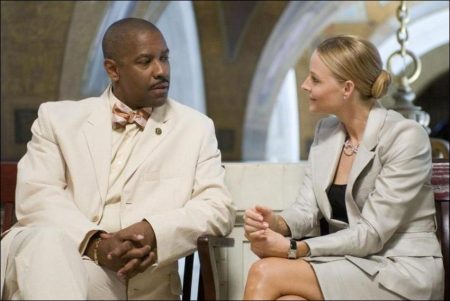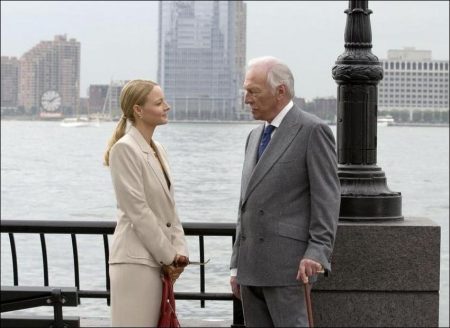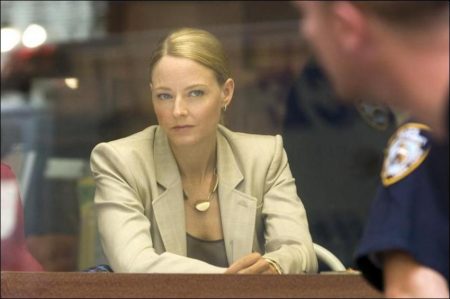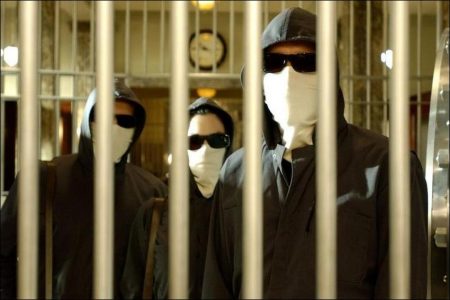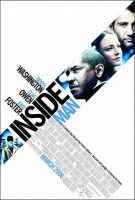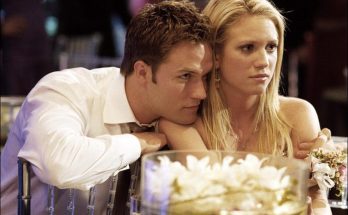Tagline: No detail is unimportant. No clue is a throwaway.
Acclaimed actors Denzel Washington, Clive Owen and Jodie Foster come together to explore the lure of power, the ugliness of greed and the mystery of a perfect robbery in a combustible new crime drama from Universal Pictures and Imagine Entertainment – Inside Man.
The powerhouse actors play tough New Yorkers who must outwit one another to protect competing interests in this skillfully penned and tightly helmed thriller. With on-screen presence that demands rapt attention, Washington, Owen and Foster portray characters who present every piece of an interlocking puzzle, but is every piece what it seems?
The three key players-Washington as a newly promoted detective who must rise above a corruption scandal, Owen as a brilliant criminal who upends what we think we know about a bank robbery and Foster as a mysterious Manhattan power broker who gets exactly what her clients pay top dollar for-collide in Inside Man, in a mainstream potboiler for Spike Lee, who teases the audience with tricks of camera and twists of plot.
By its didn’t-see-that-coming conclusion, Inside Man reveals itself as anything but your typical thriller. It all starts out simply enough: four people dressed in painters’ outfits march into the busy lobby of Manhattan Trust, a cornerstone Wall Street branch of a worldwide financial institution. Within seconds, the costumed robbers place the bank under a surgically planned siege, and the 50 patrons and staff become unwitting pawns in an airtight heist.
NYPD hostage negotiators Detectives Keith Frazier (Denzel Washington) and Bill Mitchell (Chiwetel Ejiofor) are dispatched to the scene with orders to establish contact with the heist’s ringleader, Dalton Russell (Clive Owen), and ensure safe release of the hostages. Working alongside Emergency Services Unit (ESU) Captain John Darius (Willem Dafoe), all are hopeful that the situation can be peacefully diffused and that control of the bank and release of those inside can be secured in short order.
But things don’t progress as planned. Russell proves an unexpectedly canny opponent-clever, calm and totally in command-a puppet master with a meticulous plan to disorient and confuse not only the hostages, but also the authorities. Outside, the crowd of New Yorkers grows as the situation becomes increasingly tense, with Frazier’s superiors becoming more concerned about his ability to keep the standoff from spiraling out of control.
The robbers appear to consistently be one step ahead of the police, outwitting Frazier and Darius at every turn. Frazier’s suspicions that more is at work than anyone perceives are justified with the entry of Madeline White (Jodie Foster), a power player with shadowy objectives, who requests a private meeting with Russell. The chairman of the bank’s board of directors, controlling entrepreneur Arthur Case (Christopher Plummer), is also uniquely interested in the moment-to-moment happenings inside the branch.
But just what are the robbers after? Why has nothing worked to alleviate the standoff, which stretches on hour after hour? Frazier is convinced that invisible strings are being pulled and secret negotiations are taking place as the powder keg situation grows more unstable by the moment. With loyalties and motives called into question, the detective engages in a risky game of cat-and-mouse-but with the rules of the game ever changing, one wrong move may take the volatile match closer to a disastrous and deadly conclusion.
The Puzzlemakers
Academy Award-winning producer Brian Grazer and Oscar-nominated visionary Spike Lee first met at the Academy ceremonies many years ago. Lee had been nominated in 1990 in the category of Best Original Screenplay for Do the Right Thing, and Grazer had been nominated in the same category for Splash five years prior. Throughout the years, they’d met intermittently in the hopes of collaborating on different projects, but nothing had come to fruition. Inside Man presented just the opportunity for these history-making filmmakers to finally work together.
Grazer had recently purchased a cunningly written thriller titled Inside Man from newcomer Russell Gewirtz, to be made at Universal Pictures. While scouting for a director who could take this smartly written action drama from page to screen, a chance meeting resulted in Lee’s reading the script and signing on to direct the project.
Not often does a story come along that can challenge a seasoned director so completely. Lee, who has made hard-hitting social commentary films for the past few decades, welcomed the opportunity to helm a smart, sophisticated, pressure-cooker thriller. He lauds, “Russell Gewirtz wrote a fresh, intriguing take on the genre of the bank robbery heist, and I liked the script and really wanted to do it. Dog Day Afternoon is one of my favorite films, and this story was a contemporary take on that kind of movie.”
Grazer recognized that with Inside Man, the time had finally come for the long-discussed collaboration with Lee. Grazer recalls, “When we met this time, Spike said, `We’ve had meetings and false starts, but I promise you we’re going to have a great finish.’ He looked me straight in the eye, grabbed my arm and said, `Let’s do it.’”
Grazer was as excited about the script as he was about working with Lee. “For me, originality is the thing,” he explains. “A script has to make me feel curious, and at no point can I feel complacent. In this story, it was the red herring aspect that I liked-not knowing why things were happening and later having everything revealed in such a satisfying and surprising way. These twists and turns really took the model of a heist film in a new and interesting direction.”
Grazer and Lee’s first-time partnership wasn’t the film’s only new collaboration. For a project to unite such an award-winning, accomplished assembly of cast and filmmakers, one might assume the crafty screenplay had come from a veteran screenwriter. But Russell Gewirtz holds the rare distinction of seeing his first original screenplay produced, directed and performed by most distinguished talents in the business.
After dabbling in several careers, Gewirtz spent several years living in Europe and South America, where he says the idea for Inside Man gelled. “I had some version of this story in my head for five or six years, and then crucial elements started coming together. I bounced the pitch off my good friend Daniel Rosenberg [later the film’s executive producer].” After over a year of work on Gewirtz’s script, Rosenberg shopped the finished version to a handful of the top Los Angeles agencies. One of those agents sent it to Imagine, and the rest is Hollywood history.
Reflecting on the process, the writer notes, “To say that I’ve been spoiled by this would be an understatement. It was surreal to come to the first table reading and sit down to Denzel, Clive, Jodie and Christopher delivering lines that I wrote. Then we begin filming, and I watch Spike orchestrate the entire production.” Not only was Gewirtz impressed by the all-stars bringing his words to film, he was amazed at the production value of the Inside Man set. “The team imagined and constructed an entire bank based on a few lines I put to paper four years ago. Unbelievable.”
Designing Bank Vaults and Corridors of Power
Principal photography for Inside Man took place entirely on location in New York City and ran nearly two months between June and August of 2005. Veteran production designer Wynn Thomas led the design team in creating sets for the film. His collaborations with Lee date back 20 years, all the way to Lee’s breakthrough independent feature film, She’s Gotta Have It. Those years have gone a long way to building a trusting partnership with little reason for detailed explanations.
“We’re so comfortable, we’re like an old married couple,” says Thomas of his ongoing working relationship with Lee. “We talk for about five minutes at the beginning of the film and I don’t have to talk to him again for the rest of the picture. He knows he can trust me to give him what he wants.”
One example is the set Thomas designed for Detective Keith Frazier’s apartment, which he describes as very masculine and rich and highly monochromatic in its many hues of brown. “It’s chocolate on chocolate on chocolate, “ says Thomas, “and it was my instinctual response to his living space. When Spike saw it, he said it looked like a Blue Note album cover, with all those similar tonalities.”
Thomas and his team got to work designing interior sets for a wide variety of locations-such as the NYPD headquarters, the mobile command center, an interrogation room, the bank’s basement (where the hostages are held) and Frazier’s apartment.
Scouting had zeroed in on the perfect stand-in for Branch Number 32 of Manhattan Trust-the bank’s main set was located in a former Wall Street bank that had been closed and later repurposed as a cigar bar. Thomas and his team were responsible for a major undertaking, charged with restoring the former bank to its 1920s grandeur and architectural integrity. “This movie takes place in the world of old New York money,” Thomas explains, “so we had to do extensive renovations to make the first floor look like an old-fashioned institution of money and power-it’s where the robbers first hold their hostages.”
Says Lee, “We were sweating at first, because the bank set was one of the last ones we found-and it was the most important. Without a bank, we didn’t have a movie. But everything ended up going very smoothly. We shot in the heart of Wall Street in a bank that had been closed down. It was like having a back lot in the middle of Wall Street.”
Office space for Christopher Plummer’s character, Arthur Case, was also located in an older building that formerly housed customs offices. Plummer notes, “It’s just the sort of office that J. Pierpont Morgan or Andrew Carnegie would have had. It’s just something extraordinary. The space literally presents Case’s power, so I found that part of my character was simply playing very cool about everything. You don’t have to push the power, because it’s all around you.”
Inside Man was the second production to shoot at the newly established Steiner Studios in Brooklyn, New York. The 15-acre facility at the historic Brooklyn Navy Yard is the largest production facility east of Los Angeles, newly built from the ground up. Its massive size allowed for all of the interior sets to be housed in one place.
Economy of shooting was something that Lee very much took to heart. Commenting on Lee’s commitment and focus, producer Grazer observes, “He’s very economic and wouldn’t even eat lunch. He’d just stand in the street and plan his next shot.”
Lee attributes his work ethic to his parents, most especially his mother, who has since passed away. Lee closes, “My mother was an art teacher and my father is a jazz musician, and they instilled in their children a strong foundation. My mother said, `Never be satisfied. Do your best, but keep striving onward and upward.’ I try and bring that to every movie I make.
Inside Man (2006)
Directed by: Spike Lee
Starring: Denzel Washington, Clive Owen, Jodie Foster, Willem Dafoe, Chiwetel Ejiofor, Christopher Plummer, Ashlie Atkinson, Kim Director, Cassandra Freeman, Peter Frechette
Screenplay by: Russell Gewirtz
Production Design by: Wynn Thomas
Cinematography by: Matthew Libatique
Film Editing by: Barry Alexander Brown
Costume Design by: Donna Berwick
Set Decoration by: George DeTitta Jr.
Art Direction by: Chris Shriver
Music by: Terence Blanchard
MPAA Rating: R for language and some violent images.
Studio: Universal Pictures
Release Date: March 24, 2006
Visits: 55
